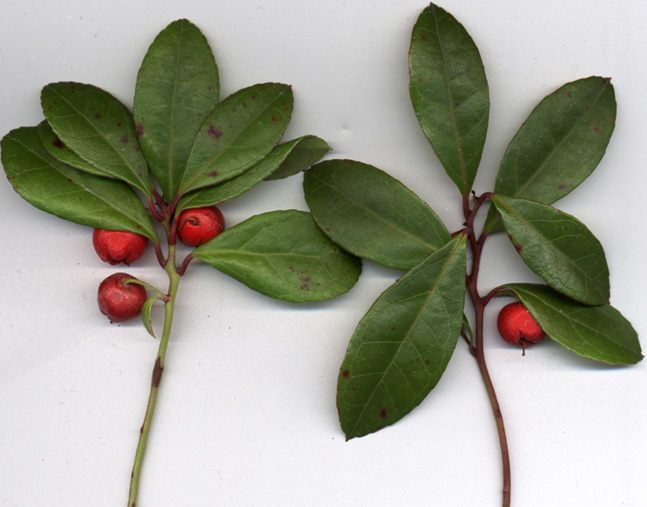Plant of the Month: January 2004
|
| Wintergreen |
| Gaultheria procumbens L. |
ERICACEÆ; Heath Family
|
| Plants that remain green through winter can be called evergreens. Several genera contain species known as wintergreen: Chimaphila, Gaultheria, Polygala, Pyrola, and Trientalis. Nonetheless, the plant most frequently called wintergreen in horticulture and in herbal medicine circles is Gaultheria procumbens, and it gets the spotlight this month. One of my favorite plants, and until now I have never written more than a few sentences about it. The impetus for writing about it now was that on December 28th I strolled through the University of Washington Medicinal Herb Garden, and noted that of 37 species affording edible green leaves or fruits on that day, this one was the most appealing. |
| I cannot think of such a choice edible berry that holds its firmness and endures as well all through the winter. In Seattle, I eat the spicy red berries between September and April --or even later into spring. Though people can also eat kinnikinnick berries (Arctostapylos Uva-ursi) all winter, they taste like cardboard. In contrast, wintergreen berries taste like oil of wintergreen. The active ingredient in this oil, methyl salicylate (related to aspirin), is widely synthesized and used as a flavoring in chewing gum, toothpaste, breath fresheners, candy, and medicines such as Pepto Bismol®. |
| Various other members of the Gaultheria genus also contain this flavorful aromatic oil. So does the eastern North American tree Betula lenta, known variously as sweet birch, black birch, cherry birch, sugar birch, spice birch, and wintergreen tree. You can chew the twigs of this birch to release the gratifying flavor; sort of like an all-natural chewing gum. |
| The genus Gaultheria was named in 1753 to commemorate Jean-François Gauthier, of Quebec, born about 1708 and died in 1756. He was a physician and naturalist. Now botanists have described more than 100 species of Gaultheria, but the first of all was G. procumbens, named in 1753 by Linnaeus. |
| It is native in much of eastern North America, and is cultivated way beyond, wherever conditions permit. Mostly it is prized as an ornamental; relatively few people use it as an edible, or medicinally. |
| To grow it successfully, give it well-drained soil with shade, adequate summer moisture, not too hot, and preferably an acidic soil high in organic matter. Avoid poor drainage. I find that in Seattle at least, it, along with certain other members of the Heath Family such as Epigaea repens, suffers high mortality rates when planted. I guess this is because of a mycorhizal association, but do not know. I do know that if you are unlucky you may need to plant wintergreen several times before a patch establishes for you and begins spreading contentedly. |
| As our scan shows, it is a small plant. I describe it as an ankle-high evergreen groundcover; a shrublet with creeping underground stems that send up little branches consisting of a whorl of glossy leaves. It is not, by the way, procumbent in a scientific sense. In summer there are small and inconspicuous nodding pinkish-white flowers that give rise to the berries. Depending on the growing conditions and the genetics, these berries will be crimson-red or more towards scarlet, and vary in size from about a third on an inch to well over half an inch. Some nurseries sell clones with especially showy fruit, and fertilize them with phosphorus to additionally enlarge the berries. |
| In spring the young leaves are very glossy, bronzy-colored, and tender. At this time they are fun to nibble raw or add to mixed salads. Very soon they become too tough to chew. But they still can be used to make a tea, or just to scratch and sniff. Traditionally, in September the leaves were harvested to use to distill the oil from. In winter the leaves often turn partly reddish or purple, at least in colder climates. |
| Other names for this species are: creeping wintergreen, aromatic wintergreen, checkerberry, partridgeberry, boxberry, teaberry, mountain tea, ivry leaves, deer berry, gingerberry, groundberry, hill berry, spice berry, and wax cluster. Some of these names are also used for different species. |
In herbal medicine the properties of oil of wintergreen are several. But overall it is far more valuable as a flavoring than as a healing agent. The oil is astringent and can be irritating, so one must use it carefully. A case existed where a child drank an entire bottle of the oil and died. And if you are allergic to aspirin you should avoid eating the wintergreen, just in case.
Back
|

Wintergreen scan by ALJ
|
|
|

